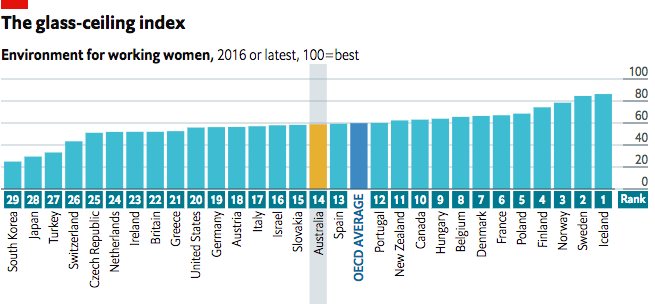
It was International Women’s Day this week, which The Economist celebrated with the release of their annual glass-ceiling index. The index looks at a combination of factors including female share of senior managers, share of company directors, cost of childcare, and the level of paid leave for fathers.
As usual, the Scandinavian countries are at the top led by Iceland. Australia hovers around the OECD average, generally below, as in this year.

Our best ranking is for participation in higher education, where Australian women rank seventh of all the countries analysed.

And our worst ranking is for paid leave for working mothers, where we only rank ahead of the US (which provides no leave for working mothers).
In my own industry, financial and insurance services, the pay gap between men and women according this analysis of the Australian workforce (from the Workplace Gender Equality Agency) to the is highest of all industries, at 25.9% (that is full-time workers who are women have a 25.9% lower base salary than full-time workers who are men, in the financial and insurance services industry). For all remuneration (including superannuation and bonuses), that rises to 33.2%.
As The Economist says in their glass ceiling index, progress has flatlined within the OECD, and that seems to be fairly true in Australia, too. The best commentary I’ve read this week on why that might be has been from Annabel Crabb in her column about Kate Ellis’ decision not to stand in the next election:
The lesson from Kate Ellis should be not: Why did this woman leave? But: How could we make people like her stay?
Much of the progress around women in the workforce has been about discriminatory barriers (we no longer have a rule that women have to leave their jobs when they get married, for example). But we need to move more jobs away from the assumption of the ideal career being a 40 year stint full-time in the workforce.
